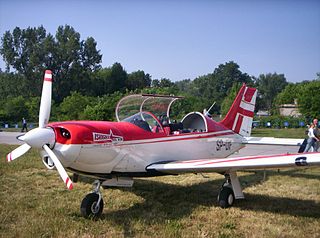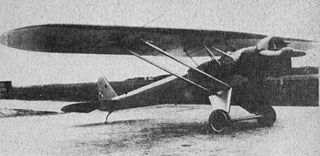Related Research Articles

The PZL TS-8 Bies is a Polish trainer aircraft, used from 1957 to the 1970s by the Polish Air Force and civilian aviation.

The Rutan Quickie is a lightweight single-seat taildragger aircraft of composite construction, configured with tandem wings.

The PZL-101 Gawron (rook) is a Polish agricultural and utility aircraft designed and built by WSK-Okęcie.

PZL M26 Iskierka or M26 Airwolf is a Polish trainer and aerobatic aircraft, designed at WSK PZL-Mielec.

PZL.19 was a Polish sports aircraft built in 1932 in the PZL works. Ordered by the Ministry of Communications, it was specifically designed for the upcoming Challenge 1932 contest held that year in Germany.

The PZL P.6 was a Polish fighter, designed by the engineer Zygmunt Puławski, manufactured by PZL state-owned factory. It remained a prototype.

PZL.26 was a Polish sports plane built in 1934 in the PZL works. Ordered by the Ministry of Defence, it was specifically designed for the upcoming Challenge 1934 International Touring Aircraft Contest.

The PZL-106 Kruk is a Polish agricultural aircraft designed and built by WSK PZL Warszawa-Okęcie.
The PZL M-24 Dromader Super is a single engine agricultural aircraft, developed in the 1980s by the WSK-Mielec from the PZL-Mielec M-18 Dromader. It remained a prototype.

PZL.12 (PZL-H) was a prototype of a Polish amphibious flying boat designed and built in 1931 by Zygmunt Puławski, a pioneering Polish designer. He was killed in a crash involving this design.

The PZL P.1 was a Polish fighter, designed by the engineer Zygmunt Puławski, manufactured by the PZL state-owned factory. It remained a prototype, but it was the first of the Polish PZL gull wing fighter series, leading to the PZL P.7, PZL P.11 and PZL P.24.

The DINFIA IA 45 Querandi was a 1950s Argentine twin-engined light transport aircraft built by the DINFIA.

The PZL S-1 was a Polish trainer and liaison aircraft of 1945, which remained a prototype. It was the second aircraft built in Poland after World War II.

The PZL M-17 "Duduś Kudłacz" was a Polish twin-boom pusher general aviation and trainer aircraft of 1977, which remained a prototype.

PZL M-2 was a Polish trainer aircraft prototype of 1958, a low-wing monoplane with a fixed gear, designed at WSK-Mielec, that did not enter production.
The Bede BD-2 was an American experimental powered sailplane designed by Jim Bede to attempt an unrefuelled round-the-world flight.

The Dornier Do K was a German commercial passenger and freight monoplane, designed by Claude Dornier and built by Dornier Flugzeugwerke. Only three prototypes of different designs were built and the type was not a commercial success.
The EADS PZL PZL-112 Junior is a Polish single engine, two-seat trainer built by PZL Warszawa-Okecie.

The Turbine Legend is an American sports monoplane designed by Performance Aircraft for sale as a kit for amateur construction.

The Quickie Q2 or Q2 is a two-seat version of the unique Rutan Quickie, produced in kit form by the Quickie Aircraft Corporation founded by Tom Jewett and Gene Sheehan. Canadian Garry LeGare was involved in the design.
References
- "Around the world without refuelling". Flight International , 30 January 1982. pp. 214–215.
- "Round-the-world pilot killed in prototype". Flight International, 24 July 1982. p. 193.
- Taylor, John W. R. Jane's All The World's Aircraft 1982-83. London:Jane's Yearbooks, 1982. ISBN 0-7106-0748-2.